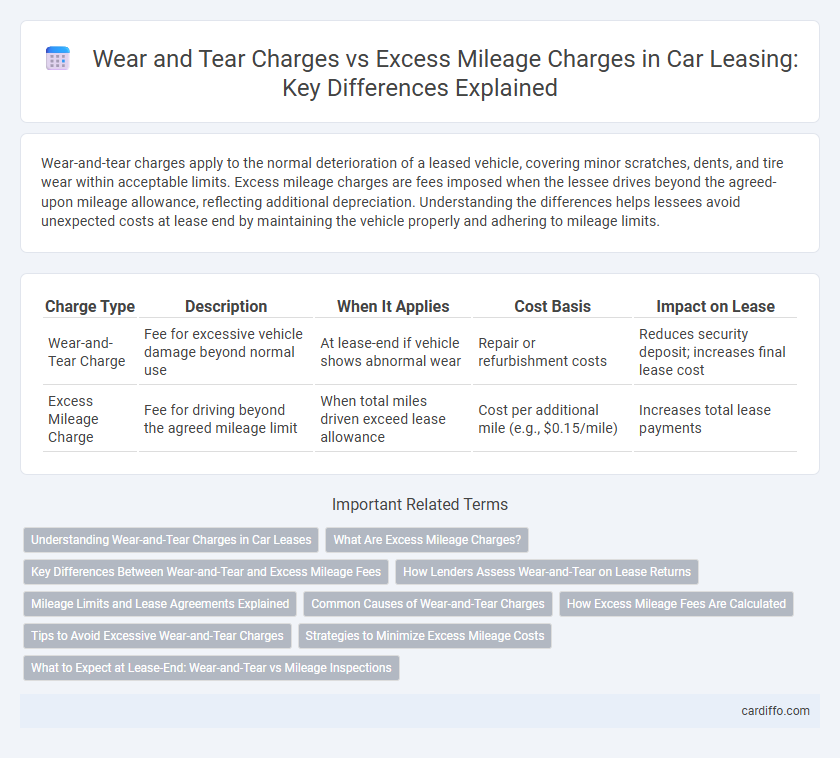Wear-and-tear charges apply to the normal deterioration of a leased vehicle, covering minor scratches, dents, and tire wear within acceptable limits. Excess mileage charges are fees imposed when the lessee drives beyond the agreed-upon mileage allowance, reflecting additional depreciation. Understanding the differences helps lessees avoid unexpected costs at lease end by maintaining the vehicle properly and adhering to mileage limits.
Table of Comparison
| Charge Type | Description | When It Applies | Cost Basis | Impact on Lease |
|---|---|---|---|---|
| Wear-and-Tear Charge | Fee for excessive vehicle damage beyond normal use | At lease-end if vehicle shows abnormal wear | Repair or refurbishment costs | Reduces security deposit; increases final lease cost |
| Excess Mileage Charge | Fee for driving beyond the agreed mileage limit | When total miles driven exceed lease allowance | Cost per additional mile (e.g., $0.15/mile) | Increases total lease payments |
Understanding Wear-and-Tear Charges in Car Leases
Wear-and-tear charges in car leases refer to fees assessed for physical damage or deterioration beyond normal use, such as dents, scratches, or tire wear, occurring during the lease term. These charges are distinct from excess mileage fees, which apply solely to miles driven beyond the contractual limit. Understanding wear-and-tear charges helps lessees anticipate potential costs that result from the vehicle's condition at lease return, guiding better maintenance and inspection practices.
What Are Excess Mileage Charges?
Excess mileage charges are fees applied when a lessee exceeds the predetermined mileage limit specified in a vehicle lease agreement, typically calculated per mile over the allowance. These charges compensate the lessor for the additional depreciation and wear caused by driving beyond the agreed mileage, often ranging from $0.15 to $0.30 per extra mile. Understanding excess mileage charges helps lessees manage lease costs effectively by monitoring their driving habits and negotiating mileage limits upfront.
Key Differences Between Wear-and-Tear and Excess Mileage Fees
Wear-and-tear charges apply to physical damage or deterioration beyond normal usage standards, reflecting the vehicle's condition at lease-end, while excess mileage charges are levied for surpassing the agreed mileage limits in the lease contract. Wear-and-tear fees typically cover issues like dents, scratches, and tire wear, whereas excess mileage fees are calculated per mile over the allowance, often with a fixed rate specified in the lease agreement. Understanding these distinct cost categories helps lessees manage total lease-end expenses and avoid unexpected charges.
How Lenders Assess Wear-and-Tear on Lease Returns
Lenders assess wear-and-tear on lease returns by examining the vehicle's condition against standardized guidelines that categorize damage severity and acceptable use levels. They focus on paint scratches, tire wear, interior stains, and mechanical issues, comparing these factors to predefined thresholds to determine if charges apply. Excess mileage charges are calculated separately based on the lease agreement's mileage limit, with penalties imposed for miles driven beyond the allowed amount.
Mileage Limits and Lease Agreements Explained
Mileage limits in lease agreements set the maximum allowable miles a lessee can drive without incurring extra costs, directly influencing both wear-and-tear charges and excess mileage charges. Wear-and-tear charges cover physical depreciation beyond normal usage, while excess mileage charges apply strictly when mileage exceeds the contractual limit, often calculated per mile. Understanding these distinctions helps lessees manage potential fees tied to vehicle condition and overuse under lease terms.
Common Causes of Wear-and-Tear Charges
Common causes of wear-and-tear charges on a lease include scratches and dents on the vehicle's body, worn-out tires, and damaged interior upholstery. Excessive staining, cracked dashboards, and broken lights also frequently contribute to these charges. Proper maintenance and regular cleaning can help minimize the likelihood of incurring wear-and-tear fees at lease-end.
How Excess Mileage Fees Are Calculated
Excess mileage fees are calculated based on the number of miles driven beyond the annual mileage limit specified in the lease agreement, multiplied by a predetermined per-mile rate set by the leasing company. This rate typically ranges from 10 to 25 cents per mile, with the total cost reflecting the vehicle's depreciation and market value loss due to overuse. Understanding the lease contract's mileage allowance and fee structure is crucial for minimizing unexpected excess mileage charges at lease end.
Tips to Avoid Excessive Wear-and-Tear Charges
Regularly clean and inspect your leased vehicle to prevent damage that could result in wear-and-tear charges. Use protective seat covers and floor mats to minimize stains, tears, and dirt accumulation. Address minor repairs promptly, such as fixing scratches or small dents, to avoid costly penalties at lease end.
Strategies to Minimize Excess Mileage Costs
To minimize excess mileage costs on a lease, carefully track your mileage throughout the lease term and aim to stay within the predetermined limits set by the leasing contract. Opt for longer lease terms with higher mileage allowances or negotiate more miles upfront to reduce the likelihood of exceeding the mileage cap. Regularly planning trips and car usage, using alternative transportation, and maintaining detailed mileage logs can further help avoid costly penalties related to excess mileage charges.
What to Expect at Lease-End: Wear-and-Tear vs Mileage Inspections
At lease-end, expect a thorough inspection focusing on both wear-and-tear and mileage. Wear-and-tear charges are assessed based on vehicle condition standards, addressing scratches, dents, or interior damage beyond normal use. Excess mileage charges apply when the odometer reading exceeds the agreed mileage limit, often calculated per mile over the contract allowance.
Wear-and-Tear Charge vs Excess Mileage Charge Infographic

 cardiffo.com
cardiffo.com